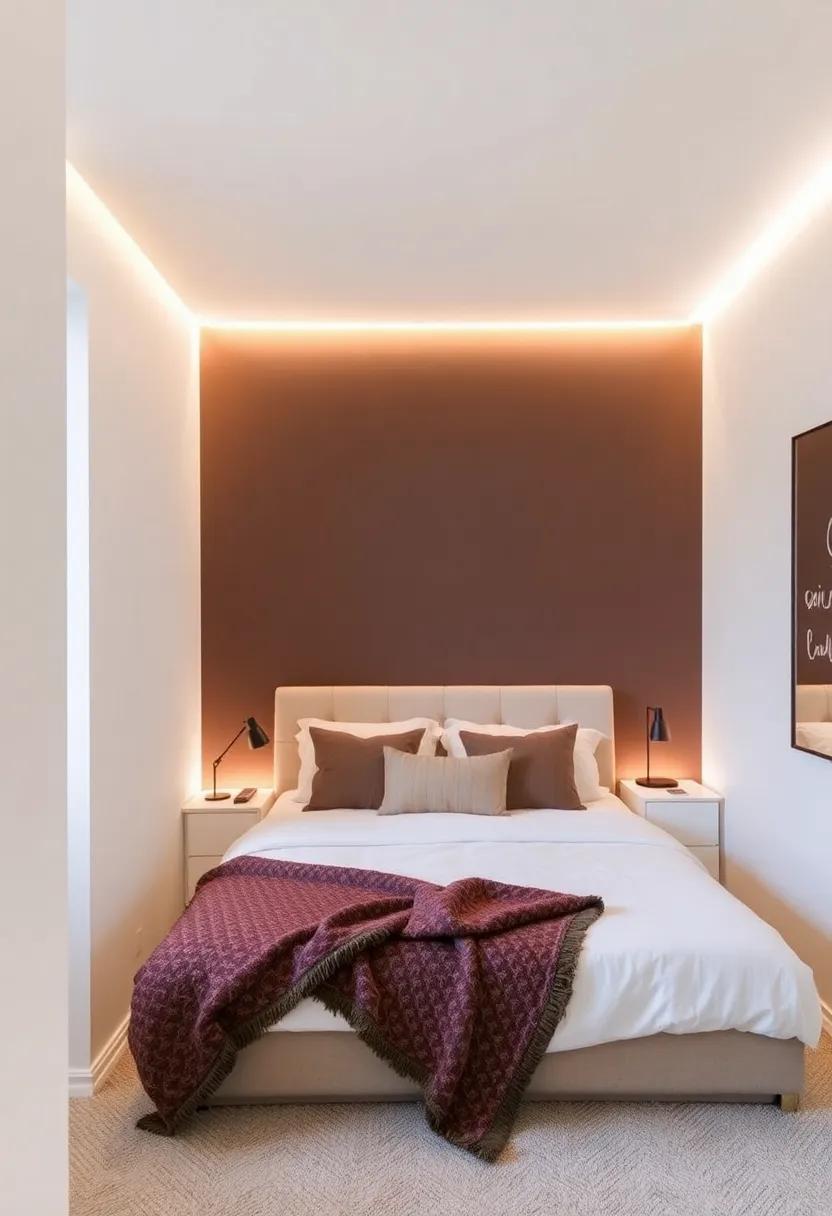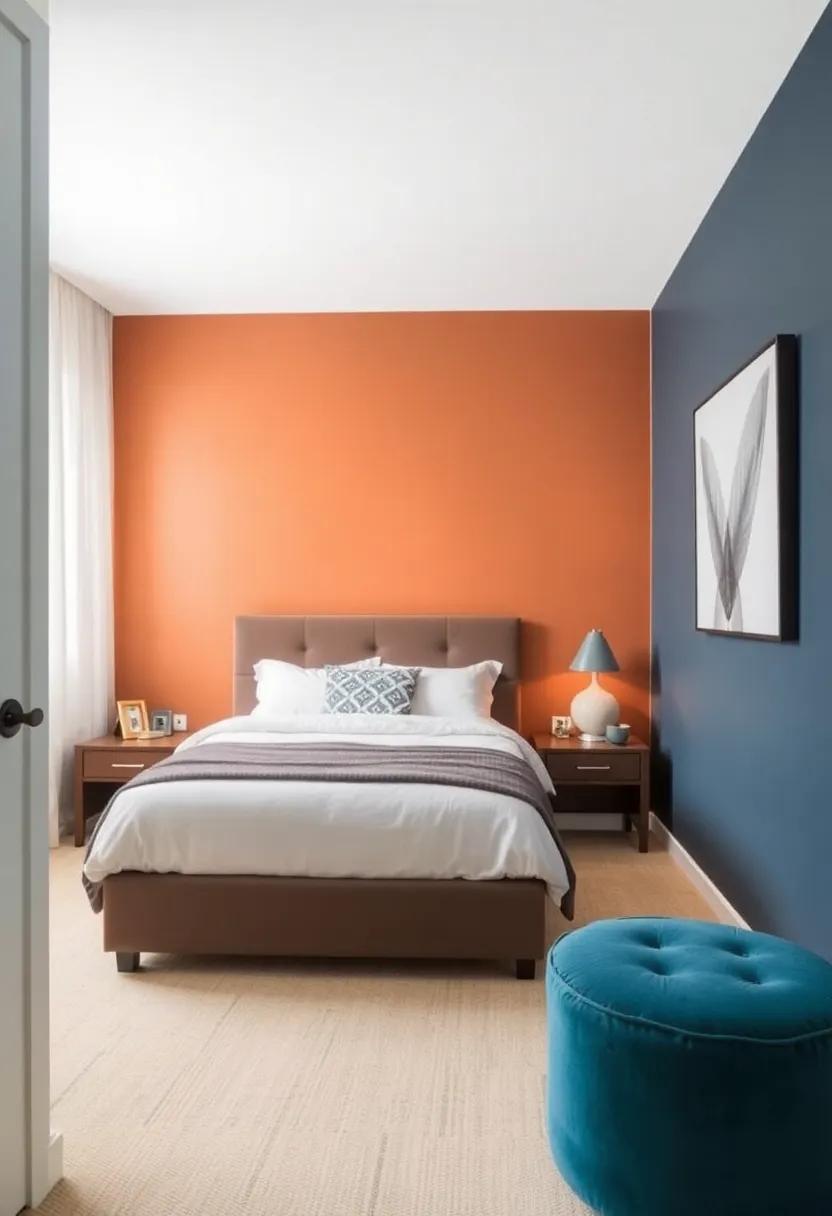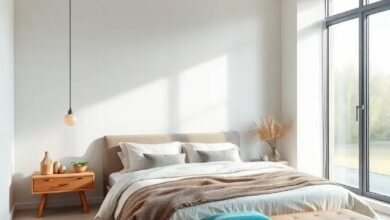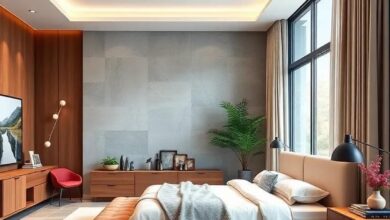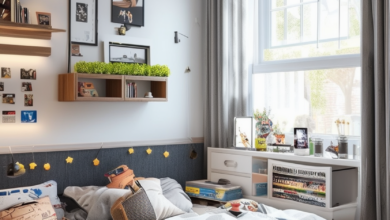
Transforming Tiny Spaces: The Magic of Accent Walls
In a world where urban living often means squeezing comfort into compact quarters, the art of decor has evolved to embrace the challenge of tiny spaces.Among the myriad design tricks that evoke warmth and style, the accent wall stands out as a beacon of creativity and conversion.This simple yet striking technique can turn a mundane wall into a focal point of personality and flair, breathing life into rooms that may otherwise feel constrained. Whether it’s a splash of bold color, an intricate pattern, or textured materials, accent walls have the power to redefine space, creating an illusion of depth and dimension. In this article, we’ll explore the enchanting world of accent walls, unveiling how they can elevate small rooms and provide practical tips for harnessing their magic in your own home. Join us on this journey to discover the endless possibilities that await behind a single wall.
Exploring the Allure of Accent Walls in Compact Living Areas
In compact living areas, the challenge frequently enough lies in maximizing the emotional and physical space. An accent wall serves as a powerful design strategy that transforms the overall ambiance of a room without overwhelming it. By selecting one wall to feature a bold color, textured wallpaper, or intricate mural, you can create a stunning focal point that draws the eye and enhances the depth of the room. This technique not only helps to delineate different zones within open-concept layouts but also provides an aesthetically pleasing contrast against the remaining walls, which can remain in neutral shades. Consider using hues that evoke tranquility, such as deep blues or soft greens, which can make the space feel larger while still adding personality.
When choosing an accent wall, it’s importent to consider how it interacts with furnishings and lighting. A featured wall can be further enhanced by incorporating decorative elements such as shelves, floating artwork, or statement lighting fixtures that complement the chosen color or pattern. Here are a few tips to make the most out of your accent wall:
- Choose a bold yet complementary color to enhance your existing decor.
- Select textures like reclaimed wood or brick for a rustic charm.
- Incorporate lighting to highlight the accent wall and create mood.
Using these techniques, an accent wall can transform a tight space into a personal sanctuary. For more inspiration on design ideas and color schemes, check out Houzz, where you can explore countless visuals and expert advice tailored to your unique space.
Choosing the Perfect Color Palette for Your Accent Wall Delight
When it comes to an accent wall, the color palette you choose can dramatically affect the ambiance of your space. Consider starting with your existing decor as a reference point. Select a dominant color that resonates with the furniture or art already present in the room; this will foster a sense of unity. Next, incorporate complementary hues to enhance the visual appeal. For a fresh vibe, look for colors that evoke feelings of serenity, such as cool blues or soft greens. Alternatively,if you crave energy,you might lean toward vibrant shades like sunny yellows or fiery oranges.
To further refine your choices, select a few swatches and test them in different lighting conditions within your room. Frequently enough,the appearance of a color can shift dramatically from natural to artificial light. Consider these essential color characteristics:
- Hue: The base color, like red or blue.
- Saturation: The intensity of the color; vibrant vs. muted.
- Brightness: How light or dark the color appears.
Creating a harmonious palette involves balancing these colors while ensuring they fit the specific purpose of the room. For additional inspiration, visit Pantone for trending color palettes that can enhance your design exhibition. an attractive color combination can transform your accent wall,elevating your entire space with minimal effort.
Materials Matter: Understanding Different Textures for Walls
When considering the texture of an accent wall, it’s essential to understand how different materials can dramatically alter the atmosphere of a space. Each texture brings its own unique character, evoking diverse feelings and enhancing visual depth. Such as, wood paneling introduces a warm, rustic charm that can make a cozy nook feel inviting, while textured plaster can evoke a sense of elegance and sophistication.Here are a few textures to consider:
- Painted Texture: A creative swirl of colors that adds movement.
- Brick: Classic and timeless, adding a hint of industrial flair.
- Fabric Panels: Softens sound and brings warmth to any room.
- Stone: Natural, rugged beauty that adds character.
Beyond just aesthetic appeal, the choice of material also impacts the lighting and dimension of the room.Smooth surfaces reflect light, making smaller spaces feel more expansive, while rough textures can absorb light, creating a more intimate atmosphere. An accent wall crafted with geometric wallpaper can infuse modernity and energy into a compact room. Here’s a simplified comparison of materials and their effects:
| Material | Visual Impact | Feel |
|---|---|---|
| Wood | Warm & Cozy | Natural & Inviting |
| Brick | Textured & Bold | Rugged & Industrial |
| Wallpaper | Vibrant & Fun | Creative & Lively |
| Paint | Sleek & Simple | Fresh & Clean |
Choosing the right materials and textures is crucial in crafting the perfect accent wall that resonates with both comfort and style. For further exploration into wall materials and their impacts, check out Houzz.
Creative Patterns and Designs to Elevate Tiny Spaces Effortlessly
When it comes to maximizing the potential of petite living spaces, accent walls can play a transformative role. textured wallpapers, bold paint choices, or creative decals can set a dramatic tone without overwhelming the room. Consider using geometric patterns or nature-inspired designs to engage the eyes and draw attention to specific areas. These visual focal points not only inject personality into your space but also create an illusion of depth, making your cozy quarters feel larger and more inviting.
Another effective way to enhance a small room is through the use of color blocking. This technique allows you to choose two or more colors that harmonize beautifully while emphasizing architectural features. Implementing a vibrant splash behind a bookshelf or a subtle gradient in your hallway can effectively break the monotony of plain walls. Additionally, you can incorporate mirrored elements to reflect light, thus adding dimension and creating a sense of airiness. For more design inspirations and tips, explore Houzz.
How Lighting Can Transform the Impact of Your Accent Wall
When it comes to accent walls, the role of lighting cannot be overstated. Consider how different light fixtures can dramatically enhance the colors and textures of your chosen wall.Natural light, as a notable example, breathes life into your space, revealing the subtleties of the paint or wallpaper. Meanwhile, strategically placed ceiling fixtures or wall sconces can create shadow play and highlight the wall’s features, leading to a more dynamic visual experiance. Explore options such as:
- Direct Lighting: Focuses on specific areas, enhancing the wall’s details.
- Ambient Lighting: Provides a soft glow that adds warmth to your accent wall.
- Task Lighting: Perfect for areas like reading nooks against your highlighted wall.
For a truly striking effect, consider the placement and intensity of your lighting. A well-lit accent wall can serve as a conversation starter and the main focal point of your room. Use dimmer switches to adjust the light levels based on the time of day or your mood, allowing the wall to transform with the shifts in lighting. You can even experiment with colored bulbs or LED strips to complement or contrast the wall’s hues, creating a multi-dimensional atmosphere. To dive deeper into lighting tips for small spaces, check out Apartment Therapy.
Integrating artwork to Enhance Your Accent Wall Aesthetic
Artwork can be the secret weapon in amplifying the ambiance of an accent wall. By carefully selecting pieces that resonate with your personal style, you can create a visually stimulating focal point that draws the eye and invites intrigue. Consider these options for integration:
- Framed Art Prints: Choose a variety of sizes and styles for an eclectic gallery wall.
- Canvas Paintings: These can add texture and depth, enhancing the color palette of the room.
- hanging Sculptures: Add dimension by incorporating three-dimensional pieces that invite touch.
- Mirrors: Not only do they create the illusion of space, but they also reflect light beautifully.
remember,the placement of your artwork is just as important as the pieces you select. Creating a cohesive layout can elevate the overall impact substantially. Experiment with arrangements by using painter’s tape to outline where pieces would go on the wall.You might also consider incorporating a small shelf or ledge to display smaller artworks or decor items. utilizing a combination of color, texture, and style will ensure your accent wall not only stands out but also harmonizes with the remainder of your space. For more artistic inspiration, explore Artsy, where you can discover a myriad of artworks to fit your aesthetic vision.
Incorporating Shelving to Maximize Space and Style
Utilizing shelving in your space is not just about storage; it’s an opportunity to enhance both functionality and aesthetics. Open shelves can transform a bare wall into an eye-catching display area while keeping everyday items easily accessible. Consider incorporating floating shelves to create an illusion of space; they blend seamlessly into the environment and keep the floor clear.Use these shelves to showcase a curated collection of books, plants, or decorative pieces that reflect your personality.Selecting unique shelf designs can also bring a sense of artistry to your space, making your walls a focal point rather than a blank canvas.
To maximize both style and practicality, think about synergy between your shelving and accent walls. You can use color or texture to make shelving pop against the backdrop of your chosen wall treatment. Such as, pairing a bold painted accent wall with light-colored wooden shelves creates a striking contrast. Additionally, incorporating shelves in various depths and widths allows for creative arrangements that can cater to your storage needs while maintaining a modern look. Here are some ideas to consider:
- Mix open and closed shelving for a balanced look.
- Integrate lighting on shelves to highlight décor.
- Use decorative baskets or boxes for organized storage.
Plant Life: Bringing Nature Indoors with Accent Wall Ideas
Transforming your indoor space with an accent wall doesn’t just amplify the aesthetics; it invites the calming essence of nature right into your home. Picture a vibrant green wall adorned with various trailing plants, like pothos or ivy, cascading down to create a breath of fresh air within four walls. By incorporating real foliage or high-quality plant-themed wallpapers,you can craft a serene atmosphere that juxtaposes beautifully against the starkness of hard surfaces. Other ideas might include utilizing botanical art or patterned decals that mimic leafy designs, thereby tying the outdoor world elegantly to indoor confines.
For those seeking a bit more flair, consider integrating a small indoor garden directly onto your accent wall using shelves or vertical planters. This not only serves as an eye-catching feature but also enhances the air quality of your living space. Here are some popular plant choices ideal for accent walls:
- Ferns – Hardy and lush, perfect for a shaded wall.
- Succulents – A low-maintenance option with ample variety.
- Philodendrons - Perfect for draping and adding life to corners.
Depending on your style, you can create a classic wood-themed backdrop or a modern geometric design that plays off the greenery’s natural splendor. To explore more about indoor gardening and styling tips, visit The Joy of Plants for inspiration and practical advice.
Personalizing your Space with Unique Wall Decals and Murals
Transforming a small area into a reflection of your personality is as simple as applying a few unique wall decals or a mesmerizing mural. These art pieces can create stunning focal points, making a compact space appear larger and more inviting.Consider using decals featuring geometric shapes, nature motifs, or abstract designs to enhance visual interest. When you choose a mural, opt for vibrant scenery or patterns that resonate with your style; this not only enhances the ambiance but also brings a sense of romance or adventure into your home. With the right choice, a simple wall can become a conversation starter, showcasing your individuality in a chic and elegant manner.
To further personalize your space, mix and match different decals and murals to create a layered effect. Here are some brilliant ideas to consider:
- Complementary Color Schemes: Choose decals that echo the colors of your existing furniture.
- Themed Arrangements: Create a story or theme through a series of related images or patterns.
- Interactive Designs: Opt for removable wall decals that can be repositioned to change your decor frequently.
- Personal Expressions: Incorporate quotes or sayings that inspire you, adding a personal touch to your decor.
In a world where personalization becomes increasingly critically important, these transformations allow you to curate an oasis that reflects who you are.For those seeking inspiration or a myriad of options for stickers, murals, and decals, resources like Etsy offer a vast selection that can cater to your unique tastes.
The Power of contrasting Elements in Small Room Design
In the realm of interior design, juxtaposition can create a captivating narrative, especially within small spaces. When implementing an accent wall, consider using vivid colors or textured materials that stand out against neutral tones. This contrast not only draws the eye but also adds depth to your room. For instance, pairing a vibrant teal accent wall with soft white furnishings can create a striking visual dynamic. Textures such as wood, stone, or even wallpaper with intricate patterns can further enhance this effect, bringing a sense of richness to your living area.
To maximize the impact of contrasting elements, focus on the following key aspects:
- Color Schemes: Utilize a bold color palette for your accent wall while keeping adjacent walls subdued.
- Materials: Mix smooth surfaces with rough textures to create interest.
- Lighting: Highlight your accent wall with carefully placed lighting to enhance its features.
Consider also incorporating furniture pieces that either complement or contrast with the wall color for an extra touch of flair. A sleek, minimalist couch against a bold backdrop can serve as a stunning focal point, inviting curiosity and admiration. By thoughtfully combining contrasting elements, your small room can transform from a mere space into a stylish sanctuary of individuality.
For more inspiration on how to play with colors and textures, visit Houzz for a myriad of ideas that can breathe life into your tiny space.
Inspiring Examples of Successful Accent Wall Transformations
Accent walls have the power to breathe new life into even the coziest of spaces. One particular transformation that stands out is the use of reclaimed wood panels in a small living room. The natural texture and warm tones of the wood create a rustic yet refined focal point that draws the eye without overwhelming the space. This kind of wall can be complemented with minimalistic decor and soft lighting,enhancing the cozy atmosphere that small rooms often need. Homeowners can opt for shades of driftwood or even vibrant hues painted onto the wood, making it an effortless way to express personal style.
Another striking example is the incorporation of geometric patterns through bold wallpaper designs. In a compact home office,a wallpaper featuring large triangles in contrasting colors can not only add depth but also create a playful environment conducive to productivity. Pairing this with sleek furnishings and open shelving keeps the space feeling organized and functional. For inspiration and ideas on how to choose the right patterns for accent walls, consider exploring resources such as houzz. The variety of options available can surely ignite creativity and bring unique flair to any tiny space.
Focal Points: Making Your Accent Wall Stand Out
When selecting your accent wall, consider incorporating textures and patterns that add depth and intrigue. Rather of opting for a simple coat of paint, think about using materials like wood paneling, stone, or even fabric. These elements can transform the ambiance of a room, making a small space feel larger and more inviting.Additionally, choose a color that evokes emotion but still complements the overall palette of your room; this could be a bold hue or a soft, calming tone. Here are some ideas to enhance your accent wall:
- Geometric Patterns – Adding a patterned wallpaper can create a unique visual impact.
- Gallery Wall – Showcase artwork or photographs that reflect your personality.
- Textured Wall Panels – Install 3D panels for an eye-catching feature.
Lighting can also play a pivotal role in drawing attention to your accent wall. By strategically placing spotlights or LED strips, you can highlight the textures and colors that make your wall pop. Consider the following tips to maximize the effect of your lighting:
- Wall Sconces - Install sconces to create a warm, inviting glow.
- Backlighting - Use backlit options to add drama and depth.
- Adjustable Fixtures – Choose adjustable lighting to draw focus to different aspects of your wall as the mood changes.
For more ideas on creating captivating spaces, check out Architectural Digest.
DIY Accent Wall Ideas for the Budget-Conscious Decorator
Creating an eye-catching accent wall doesn’t have to break the bank. One affordable option is to use removable wallpaper. With various patterns and textures available, you can easily change the look of a space without the commitment of traditional wallpaper. Additionally, consider using paint techniques such as ombre or sponge painting to add depth and character to your walls. For an even more budget-amiable approach,explore your local thrift shops for salvaged wood or reclaimed materials,which can be transformed into a stunning feature wall with just a little effort and creativity.
If you’re feeling crafty, DIY stencils can provide an artistic flair while keeping costs low. Simply create or purchase a stencil design that resonates with your style and use it to apply paint directly onto your wall. Alternatively, gallery walls are an excellent way to showcase personal artwork or family photos while adding visual interest. You can achieve this look with a collection of inexpensive frames in various sizes, arranging them to create a cohesive design. Whichever method you choose,the goal is to reflect your personality and make the most of your space while staying within your budget. Explore more ideas at Better Homes & Gardens.
Using Wallpaper to Add Depth and Character to Tiny Spaces
When working with limited square footage,clever design choices can work wonders. One of the most impactful ways to enhance a small space is by applying wallpaper to create an accent wall that instantly elevates your interior design. Choose bold patterns or rich colors to draw the eye and create the illusion of more depth. By introducing a striking visual element, you can transform a mundane corner into a charismatic focal point. Consider these tips for selecting and applying wallpaper:
- Select a pattern that resonates: Opt for designs that reflect your personality—subtle floral prints, geometric shapes, or even whimsical motifs.
- Play with color: Rich hues can give the illusion of depth, making walls seem farther away.Light colors can brighten the room, creating an airy feel.
- Consider texture: Textured wallpaper can add another layer of visual interest, creating shadows and highlights that enhance the sense of space.
Additionally, the proper placement of wallpaper can make a world of difference. Consider emphasizing an architectural feature, like a fireplace or a built-in shelf, or framing a nook with wallpaper to create an inviting retreat. To further refine the look, complement the wallpaper with decorative elements that resonate with its style—such as sleek shelving, vintage mirrors, or hanging plants. These finishing touches not only enhance your aesthetic but also promote functionality, helping you make the most of every square inch. Research more ideas on House Beautiful to explore diverse wallpaper inspirations.
Accent Walls in Different Rooms: Adapting to Every Environment
Accent walls can breathe new life into any room, allowing you to tailor your space artistically to your needs. In cozy living rooms, for example, a bold hue or an intricate wallpaper pattern can create a focal point without overwhelming the space. Consider using dark blues or rich greens to add depth, or go for vibrant yellows or corals to infuse energy. Transformations can be easily achieved through various materials, from reclaimed wood to textured tiles, bringing warmth and character to even the tiniest of spaces. Don’t shy away from using geometric patterns or mural designs that resonate with your lifestyle and personal taste.
In bedrooms, an accent wall can serve as a dreamy backdrop that enhances tranquility and relaxation.Soft pastels or gentle earth tones can promote restfulness, while a striking floral design can introduce a touch of whimsy and romance.For those who wish to make a more dramatic statement, consider a metallic finish or bold wallpaper with floral accents. The bathroom, frequently enough overlooked, can greatly benefit from a unique accent wall too. Create a spa-like ambiance with subtle textures or moody colors, keeping maintenance in mind. Remember, the possibilities for adapting accent walls are only limited by your inventiveness! For more inspiration on color schemes and patterns, visit Houzz.
Layering Textures: Creating Visual interest in Small Rooms
In small spaces, the key to creating an inviting atmosphere lies in combining different textures. By layering materials such as wood, fabric, and metal, you can develop a rich tapestry of visual interest that stretches beyond mere color. Consider incorporating textured wall panels, woven tapestries, and glossy surfaces to add depth to the environment. When these diverse materials are brought together, they interact with light and shadow, creating a sense of dynamism that softens the confines of smaller rooms.
To maximize the impact of textured layering, it’s essential to establish a coherent palette that harmonizes yet contrasts effectively. Some strategies include:
- Mixing different finishes: Pair a soft matte wall treatment with a glossy accent piece.
- Incorporating textiles: Use throw pillows or blankets that boast varying patterns and materials.
- Choosing a statement piece: A large framed mirror can reflect the room’s texture while enhancing perceived space.
The following table illustrates some ideas for texture combinations tailored for small rooms:
| Texture 1 | Texture 2 | Recommended Use |
|---|---|---|
| Wood | Fabric | Accent chairs with woven cushions. |
| Brick | Metal | Industrial shelves against a rustic wall. |
| Glass | Leather | Clear coffee table and leather sofa combination. |
For more insights on design and decor, visit elledecor.com.
How to Harmonize Accent Walls with Existing Decor
Creating a stunning accent wall in a small space can feel overwhelming, especially when trying to complement the existing decor. One efficient way to achieve harmony is to choose a color or pattern that resonates with your furnishings. As a notable example, if your room features a lot of warm tones, consider a rich burgundy or terracotta for the accent wall. On the other hand, if your pieces are modern and cool, a teal or soft grey might work wonders. To tie everything together, use decorative elements that incorporate the accent color, such as cushions, artwork, or curtains. This helps create a fluid transition throughout the space, linking the accent with other aspects of the room.
Texture also plays a crucial role in harmonizing an accent wall with your decor. Consider adding various surfaces or materials to enhance visual interest. For example, if your wall is painted, you could incorporate wooden shelves, metal accents, or even wall-mounted planters that add dimension. Another effective technique is to leverage lighting to highlight the accent wall, making it a focal point without overshadowing your existing decor. Here’s a simple table to inspire you with potential combinations:
| Accent Color | Suggested Decor Pairing | Texture/Finish |
|---|---|---|
| Teal | White furniture | Satin finish paint |
| Burgundy | Natural wood | Matte finish paint |
| Soft Grey | Metal accents | Glossy finish paint |
For additional tips on color coordination and interior design, consider exploring House Beautiful, which offers a wealth of inspiration to help you make the best choices for your space.
Future Trends in Accent Wall Designs for Urban Dwellings
As urban living continues to evolve, accent walls have emerged as a focal point in modern design, allowing residents to inject personality into limited spaces. The future of these visual statements is poised to embrace lasting materials and eco-friendly practices. With a growing emphasis on environment-friendly living, expect to see more innovations, such as walls crafted from reclaimed wood, bamboo, or recycled materials that not only minimize carbon footprints but also add a unique character to an urban home.Additionally, technology is on the rise, with features like smart wallpapers that can change colors or patterns through app control, creating dynamic environments that adapt to the owner’s mood or activity.
the use of bold colors and textured finishes will dominate accent wall trends, offering a blend of warmth and sophistication to small urban apartments. Minimalism will still play a role, but expect this to be complemented by impactful designs that create depth and dimension. Patterns referencing nature, geometrics, and even abstract art will become increasingly popular, providing visual interest without overwhelming a space. Incorporating elements like vertical gardens or 3D wall panels will invite nature into homes, blurring the lines between indoors and outdoors. For further inspiration on sustainable home design, check out Elemental Green.
final thoughts
As we conclude our exploration of transforming tiny spaces through the captivating allure of accent walls, it becomes clear that with a stroke of creativity and a splash of color, even the smallest of rooms can command attention and evoke emotion. An accent wall serves as a canvas, inviting us to express our individuality and to reimagine our surroundings, reflecting personal stories and styles.Whether you opt for bold patterns, soothing hues, or textured finishes, the impact of a thoughtfully designed accent wall can breathe new life into cramped corners, making them feel expansive and welcoming.As you embark on your own journey of transformation,remember that the true magic lies not just in the design,but in the feelings it inspires and the memories it can hold. Embrace the possibilities that lie within your tiny spaces,and let the walls tell your story—one brushstroke at a time. After all,in the universe of design,the smallest gestures often create the most profound changes. So grab that paint, that wallpaper, or those panels, and make your mark today!
As an Amazon Associate I earn from qualifying purchases.




